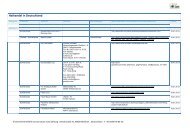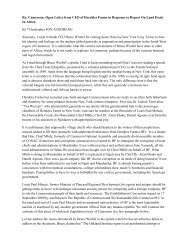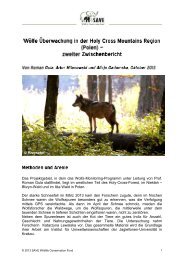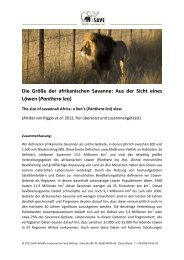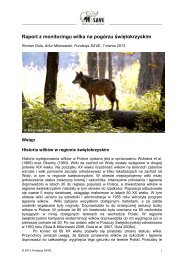African Lion
African Lion - SAVE Wildlife Conservation Fund
African Lion - SAVE Wildlife Conservation Fund
- No tags were found...
You also want an ePaper? Increase the reach of your titles
YUMPU automatically turns print PDFs into web optimized ePapers that Google loves.
3. Diseases such as LLF and the FIV Virus (Feline Immunodeficiency Virus)<br />
A dramatic problem among the wild cat populations since 1995 are the diseases LLF and FIV. Especially in the<br />
southern part of Kruger National Park in South Africa, tuberculosis and the FIV virus have taken their toll on lions. To<br />
this date, there is no vaccine for these diseases.<br />
Tuberculosis, which affects the digestive tract, is transmitted to lions through the eating of buffalo, which are virus<br />
carriers through domestic cattle. <strong>Lion</strong>s with tuberculosis lose so much weight in such a short period of time that<br />
among other things, they are prone to more illnesses such as the FI Virus. Hence, mortality rates go up. Almost 90 %<br />
of the lions living in Kruger National Park have this bacterial infection. In 1962, it was an epidemic of biting house flies<br />
that killed many wild cats. As a result, a genetic shift took place, reducing the genetic diversity drastically.<br />
Most likely, the bacteria and viruses are originally brought to Africa by domestic dogs. 1000 lions died in the Serengeti<br />
in 1994 because of dogs that carried them. However, since house dogs can not survive in wildlife parks, there must be<br />
an animal that acts as an agent. Many study cases were performed and discoveries were made that 96% of all lions<br />
have an anti-body for the Feline-Herpes-Virus. 42% have an immune complex for the Feline-Immune- Deficiency-Virus<br />
and 26% have one for the Canine-Distemper-Virus. Furthermore, experts found that the viruses in Botswana and<br />
Tanzania form their own sub type. In Tanzania, it is said that the animals were infected by the Fi-virus much earlier<br />
than it broke out. Similar to the Human Immunodeficiency Virus, it can take up to four years for an outbreak to occur.<br />
In cases as such, it is most likely that jackals are the agent. A way to determine the rate of infestation faster and more<br />
efficiently would be affordable urine tests.<br />
A simple vaccination for house-held dogs alone would protect from such infectious diseases. Unfortunately, although<br />
several of these vaccinations are on the market, they are usually not enforced. Beyond that, a better control and a<br />
registration of dogs would also be a productive attempt. A different approach would be to genetically mix the lions<br />
from Kenya and South Africa.<br />
Obviously, there is still much to be done when it comes to calling attention to the problem, educating and actually<br />
implementing solutions.<br />
© SAVE







